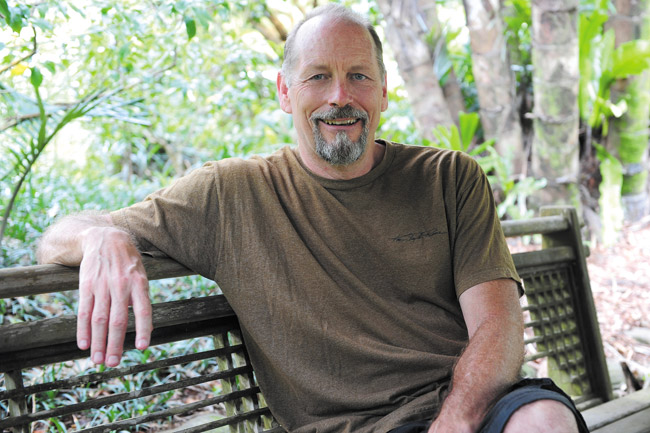Harvesting Medicine In The Wild
David Bruce Leonard
Acupuncturist, herbalist and founder of Earth Medicine Institute
Where did you receive your training in earth-based medicine?
I originally was trained as a Chinese herbalist. My former wife was an herbalist, so I began to study herbal medicine in the Rockies, and I went to acupuncture school and studied Chinese herbs. Then I moved to Hawaii and was fortunate to have many traditional Hawaiian medicine teachers who took me under their wings. Based on that knowledge, I founded Earth Medicine Institute. I’ve also published several books, including Medicine at Your Feet: Healing Plants of the Hawaiian Kingdom, Wild Wisdom: Listening to the Heart of Nature and How to Worship the Goddess & Keep Your Balls: A Man’s Guide to Sacred Sex.
What interested you in the field of Chinese medicine?
It all started when I was a teenager and I was walking down the street in Kathmandu, when I had a sudden idea that I should be doing acupuncture. I always spent a lot of time in the woods as a kid. When I came to Hawaii, I had just come from studying with my Chinese teachers. They were amazing herbalists, but they used dried herbs and didn’t know what the live plants looked like. So I sought out Hawaiian teachers. Because I was always an environmentalist, I realized this wasn’t just about using herbs for medicine ― this was about changing our frame of reference completely. Our ancestors were hunter-gatherers and, in order to survive, they had to be intimately connected with their immediate environment. Right now, what we need is to reconnect so that we care about our environment.
I tell my students, “If we could really feel our bodies and know what’s going on in them, we would never let a forest be clear-cut.” It’s not just about “resources,” it’s about reclaiming the parts of our nervous system that we’ve lost since the Renaissance.
How long have you been involved with alternative medicine?
I started as a teenager and then I really got into it 28 years ago, when I was about 30 years old. I dove in and I haven’t come up for air since.
Can you talk about some of the classes you teach?
I teach throughout the state. I do certification classes. I have a 100-hour certification class coming up for five weekends on Oahu. It begins Oct. 25-26, and then we have a weekend in November, one in December and two in January. I also teach classes through Down to Earth. I teach a lot of free, introductory classes.
The certification looks at 30 plants in depth. When the students are done, they know 30 local plants and how to use them or when not to use them. They learn the Latin names, indications, dosage and combinations.
We also add in a lot of material. We teach qigong and a class on plants and body work, which is topical uses for plants. We have someone who teaches herbal cosmetics. We teach wild fermentation and wild edibles. We also do a nature skills certification, where we teach shelter building, fire starting, tracking, listening to the language of birds and celestial navigation.
Do you go out into nature and look at plants with the students or do you already have them gathered?
We do both.
Can you talk about applied use of plants?
On one hand, we can look at plants and treat them as if they were drugs and medicines, because they can be used like that. But there is a whole other side that we must embrace if we want to use our medicine effectively. We are much better off using both halves of our brain. There’s an intuitive side of medicine that is not used in Western medicine because those practitioners are habituated to their own practices. But traditional peoples throughout history have used that intuitive place to keep them connected to the world and to their patients. There are specific gathering techniques and practices that change our nervous system. There are neurological techniques that are the same all over the world, that traditional people do when they’re gathering plants.
When you meet someone who is creepy, the part of you that knows that person is creepy is the same part of you that will listen to a plant. This information is just as important as knowledge, as data. Earth Medicine engages our whole body, and once our bodies are activated or engaged, then we can plug into nature and start caring about the natural world and the fact that so much of it quickly is being eradicated.
Can you give some introductory insight into native Hawaiian healing plants?
We do study some native plants, but what we really look at is the weeds. At least 80 percent of the plants we teach about are weeds that grow in tropical places, not just in Hawaii, but around the world. When somebody studies at Earth Medicine Institute, they can basically go anywhere along the equator or semitropical areas and find medicine and food.
Really, weeds are a top alternative medicine resource?
Yes. It’s a paradigm shift because we’re seeing things we think are against us, when actually they have a perfect place in our lives.
Anything else you’d like to mention?
We can only care about what we know, and the more we know about what’s around us, the more we’ll care about it and the less tolerant we’ll be of allowing it to be destroyed.
For more information, call 937-4218 or visit earthmedicineinstitute.com.






